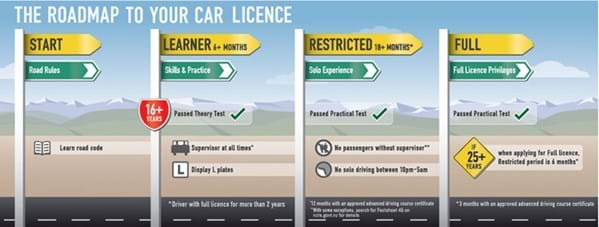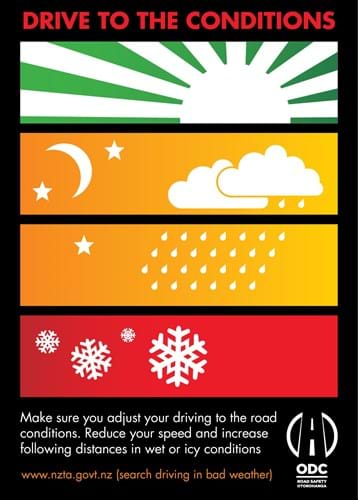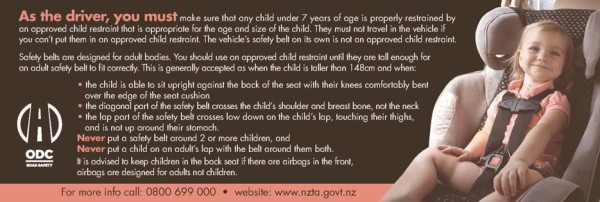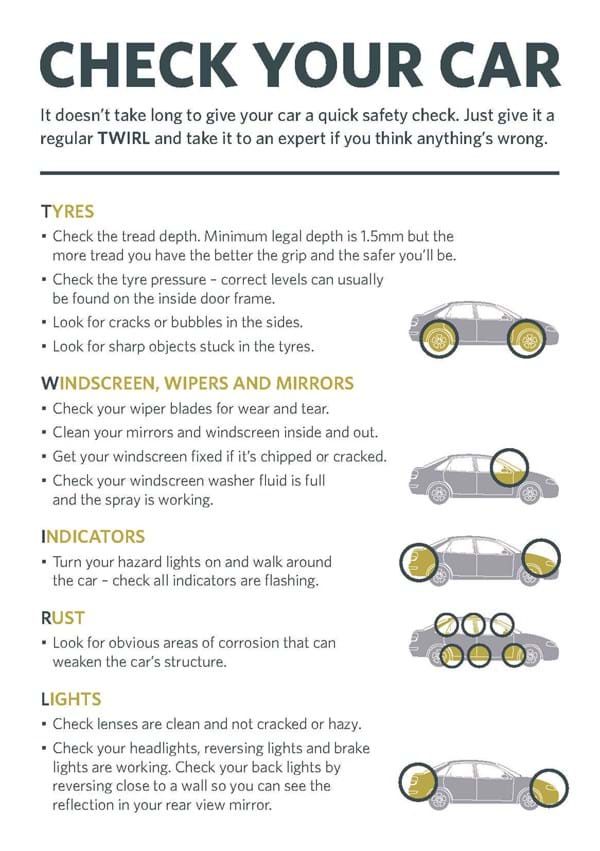Do you have road safety concerns?
When it comes to road safety, our primary consideration for our roading network is to ensure that it is safe for you to travel on. If you have any safety concerns about any part of the road network, please let us know.
Your concerns may be related to:
- Poor visibility along the road
- Sudden sharp curves in the road
- The way a contractor is operating
- The standard of repair being undertaken
- Stock on the road
- Slippery road surface
- Improved signage required
To raise your concern, you can contact us or Report an Issue.
Getting your car driver licence in New Zealand involves a three-step process. As you progress through the stages you gain a new licence with fewer requirements and more responsibilities. It’s an approach that ensures all fully licensed drivers have the skills and experience to drive safely on our roads.

Learner Licence
A learner licence is the first step of the three-stage process to get a driver licence.
Restricted Licence
A restricted licence is the second step of the three-stage process to get a full driver licence.
Full Licence
This page tells you the process to get your car full licence, and what you need to know about holding a full licence.
Advanced Driving Course
You can do an approved driving course once you have got your learner or restricted car licence
Supporting Senior Drivers
Many older people rely on their car to get around. Having a car makes it easy to go shopping, get to appointments and catch up with friends – without having to ask anyone else for help.
Some people will be able to keep driving well into their 80s and 90s. Others may have to stop driving because they can’t renew their driver licence after they turn 75.
If you have an older friend or relative who is still driving, you can help them:
- keep a check on whether they’re still able to drive safely
- plan ahead so they can get around safely and easily if they have to stop driving for any reason.
This booklet suggests ways you can help them stay mobile for as long as possible – with or without a car.
Supporting Senior Drivers Booklet (pdf 1.3MB)
Driving in bad weather
If it is raining, icy, snowing or foggy, conditions on the road will be more dangerous. You need to drive with extra care.
Check your vehicle
Effective brakes, tyres, windscreen wipers, lights and steering are even more crucial in wet weather. Check your vehicle regularly to make sure they are all in good condition.
Adjust your driving
Wet, frosty or icy roads can be very slippery. You need to increase your following distance because it takes longer to stop on a slippery surface. You should increase your following distance from four seconds to six seconds.
Watch your visibility
Visibility (how far you can see) can be seriously reduced by rain, snow or fog. This can increase the risk of a crash. To improve visibility, keep all windows and mirrors clean. Don’t let windows fog up – turn on the demister or open a window.
Brake carefully
Unless your vehicle has anti-lock braking system (ABS) brakes, don't brake too hard when it is wet. You may go into a dangerous skid. Instead, pump the brakes gently. If your vehicle has auxiliary brakes read the instructions. Don't operate them at full power in slippery conditions.
If your vehicle has ABS brakes, never pump the brakes in an emergency. Keep the pedal pressed down hard and steer out of trouble. Don't become over-confident in your driving just because your vehicle has ABS brakes.
Reduce speed
On a wet road, driving at the speed limit could be too fast for the conditions. You can lose control very easily in wet weather, especially if you have to brake suddenly, so slow down.
Dip your headlights in fog
If you drive with your headlights on full beam in fog, the light will just reflect back on you. Dip your lights - it will be much easier to see.
Don't just turn your park lights on. They are hard for oncoming drivers to see and do little to improve your vision.
You can use front fog lights when driving in fog. These have a wide, low beam and produce either a white or yellow light.
Rear fog lights, which produce a high-intensity red light, should only be used when visibility is very bad. (In normal conditions, they can dazzle drivers following you.)
Fog lights should be switched off as driving conditions improve.

Most people with young children already know the importance of the three stages of Child Restraints. We don’t want to lose even one child in a crash because they are not fitted correctly in their child restraint.
There are three stages of Child Restraints. With all three stages you must carefully follow the manufacturer’s instructions. The safest place for a child restraint is the back seat.
Stage 1: Rear-facing infant restraints
The baby is facing the rear of the car. Never put a rear-facing restraint in the front seat if there is an airbag. Chest clips sit at the baby’s armpit level. Blankets should only put on after the baby is firmly secured into the harness. Stay in a rear-facing restraints until they are at least two years old or are over the restraints manufacturer’s recommended weight or height restrictions.
Stage 2: Forward-facing child restraints
Your child restraint should not wobble. If it does not fit firmly, seek advice from a registered child rest restraint technician. If the restraint comes with a tether strap it must be used. If your car does not have an anchor point, you must have one fitted by a qualified mechanic. Chest clips sit at the child’s armpit level. Harnesses must fit snugly and comfortably against your child. Children have outgrown their restraints when they are over the manufacturer’s recommended weight or height for that model.
Stage 3: Booster seat
Never use a booster with a lap belt only. The back seat is the safest place for a child booster. If the booster has a harness use it until the child reaches the manufacturer’s height and weight limit.
Use the safety belt guide if there is one. The safety belt goes over the child’s shoulder, not resting against the child’s neck. A full booster with an adjustable head rest will provide better protection than a booster cushion.
Up until a child’s 7th birthday it is a legal requirement to use a child restraint while travelling. However, the real measure of safety is not age, it’s height. It is safer to wait till the child is at least 148cm tall.
Reminders:
Always read your car manual and child restraint manual before buying a car seat or booster seat.
All booster seats and child restraints must meet approved Safety Standards.

The risk of a motorcyclist being killed or injured in road crashes is 21 times higher than for car drivers over the same distance travelled. Riding a motorcycle requires a different set of skills and a higher level of vehicle control than driving a car. The potential outcomes of any crash, whether caused by the rider, other road users, the road environment or the vehicle itself, are more severe for motorcyclists.
At Intersections
Many crashes happen when a driver does not see a motorcyclist, especially at intersections. Here are some helpful hints and tips:
- Continuously scan ahead for traffic.
- Always ensure that traffic waiting to turn at the intersection ahead can clearly see you. Be aware that you and your motorcycle might be in the blind spot generated by the vehicle in front.
- When approaching intersections, you need to be clearly visible to all turning traffic at all times. You may need to adjust your approach position, depending on whether traffic is waiting to turn from the left or the right.
Rider Skills Training
Brush up on your riding skills for summer with 8 hours of Ride Forever motorcycle training from $20. You’ll cover the key motorcycle control skills of positioning, speed management, progression, stability, and much more.
From learning how to keep yourself safe on the daily commute to honing the most advanced riding techniques, there’s a Ride Forever course to suit your needs.
Motorcycle Safety Gear
Protective gear is a must for every ride. The essential items are:
- Helmet - by law, you must wear a helmet to protect yourself from head injury
- Boots and gloves – to prevent breakages and abrasion
- Jacket or leathers – one- or two-piece suits to protect against abrasions
High visibility gear is becoming standard for riders and is easily available. Bright clothing, backpacks and bikes can also improve visibility to car drivers.
Report an Issue
Please inform us of any maintenance required, such as reporting a pothole or loose gravel by using our report it form.
It doesn't take long to give your vehicle a quick safety check. Just give it a regular TWIRL and take it to an expert if you think anything is wrong.
